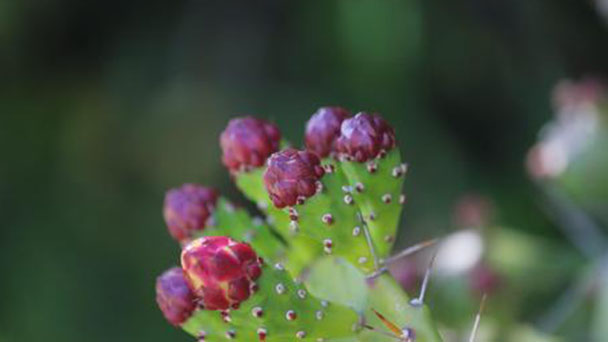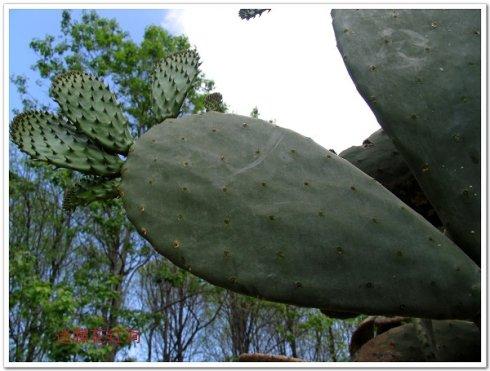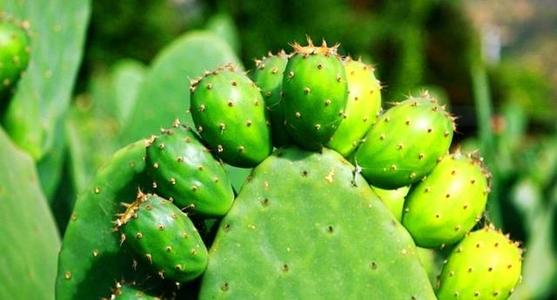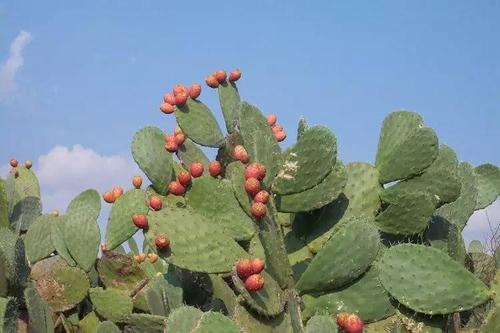Prickly pear profile
Written by Maggie
Feb 08 2021

The Prickly pear is the root and stem of the genus Cactus in the family Cactus. The Prickly pear’s origin is in Mexico, now distributed in China's Fujian, Taiwan, Guangdong, Guangxi, Sichuan, Yunnan and other places. The Prickly pear has the effect of clearing lung and relieving cough, cooling blood and detoxification. It is commonly used in cough of lung heat, tuberculosis and hemoptysis, dysentery, hemorrhoid blood, mamas, mumps, mumps with mumps, bunbuncles swelling poison, scalding burn on mumps, balding scabies, snake insect bite.
Prickly pear picture

Characteristics of the prickly pear
The Prickly pear is 1.5~5m, old plants can have cylindrical trunk. Branches are numerous, pale green to grayish green, dull, broadly elliptic, obovate-elliptic to oblong, margin entire, base rounded to broadly cuneate, surface flat, glabrous, with many vices; Small vices of The Prickly pear are slightly cushion shape, no thorns, or with 1~6 open white thorns; Receptacle is oblong to oblong-obovate, with many cushion-like vices, without spines or with a few setaceous spines; Calyx-shaped perianth segments dark yellow or orange yellow, with orange - yellow or orange - red mesribbed, broadly ovoid or ovate; Sepals of The Prickly pear are dark yellow, 2.5 -- 3.5cm long, orange yellow or orange red, ovate to oblong-ovate; Filaments of The Prickly pear are pale yellow; Stigma (6~) 7~10, yellow-white. Berries of The Prickly pear are elliptic globose to pear-shaped, with 25 to 35 nests on each side. Seeds are majority, kidney elliptic.
Biological characteristics: The Prickly pear is a fleshy shrub or small tree, in the elevation of 300~2900m dry hot river valleys or limestone mountains.
Prickly Pear's nutritional ingredient
Prickly Pear is a nutritious and healthy vegetable. The Prickly pear is a succulent and succulent plant with a water content of about 90%. The chemical composition of the stem slice of Prickly Pear is 85% ~ 90% water content, 5% ~ 12% crude protein content, and 2% ~ 6% carbohydrate content, which is similar to other leafy plants.The fruit of the Prickly Pear contains high levels of glucose and fructose, around 6 to 8 percent. While the protein content is low, the content is 3.2%-5.5%; The Prickly pear contains high fiber, neutral detergent fiber content of 22.7% ~ 27.1%, acid detergent fiber content of 12.0% ~ 16.0%, vitamin C content of 23 mg/100g, and rich in potassium, calcium, phosphorus, iron, magnesium and other mineral elements.

Prickly Pear functions
1. Bacteriostasis:
Study showed that the antibacterial effect of The Prickly pear extract was related to the variety of cactus, and wild cactus extract had obvious inhibitory effect on Escherichia coli and Bacillus subtilis.
2. Lower blood pressure:
The study showed that after intravenous injection of The Prickly pear extract, the blood pressure of dogs decreased rapidly and steadily, and the average hypotensive maintenance time was 62.2min, which was significantly different from that before administration.
3. Anti-tumor effect:
The experiment showed that the The Prickly pear extract had a good inhibitory effect on the early stage of tumor development in mice.
4. Improve the immune function of the body:
Scientists found that The Prickly pear extract could promote the generation of antibodies, enhance the function of the reticuloendothelial system, and significantly increase the body's humoral immune function, but had no obvious effect on cellular immunity.
5. Antioxidant and free radical scavenging:
The Prickly pear is a bilayer composed of phospholipids and proteins. One of the main functions of The Prickly pear is to prevent the invasion of reactive oxygen species to prevent the membrane function decline caused by lipid peroxidation. These reactions, if left uncontrolled, can lead to diseases such as cancer or atherosclerosis.
It has been reported that flavonoids play a similar antioxidant role in biological systems such as plasma lipoprotein or subcell membrane.
6. Analgesic effect:
Scientists showed thatThe Prickly pear flavonoids had a pain effect on mice through torsion and warm bath analgesia experiments, and the analgesic effect was better than that of aspirin and normal saline.
7. Anti-inflammatory effect:
Studies have shown that flavonoids isolated fromThe Prickly pear have inhibitory effect on NO released by mouse macrophages. Flavonoid compound C ring 2,3 double bonds play a key role in inhibiting NO activity, while the position and number of carbonyl groups on the ring have NO significant effect on NO activity.

Latest Updated
- Benefits of Bugleweed - 7 Science-backed Health Benefits
- Bugleweed Dangers & Side Effects - Is It Poisonous?
- How to Plant Evergreen Trees - What You Should Know
- When to Plant Evergreens - Grow Guide for Evergreen Trees
- 12 Wonderful Evergreen Shrubs for Your Garden
- 12 Popular Evergreen Plants with Pictures for Beginners
- When And How To Prune A Lilac Bush Like a Pro
- How to Grow & Care for Lilac Vine (Hardenbergia Violacea)
- Japanese Lilac Tree (Syringa Reticulata) Care & Propagation Guide
- Shumard Oak Pros and Cons - What to Know
Popular Articles
- Winter maintenance of Antirrhinum Majus
- How to Grow Terminalia Mantaly Tree
- How to Grow and Care for Crossostephium Chinense
- How to grow Antirrhinum Majus in spring
- Peristeria Elata (Dove Orchid) Profile: Info & Care Guide
- Underwatered Snake Plant (Sansevieria Trifasciata) - Signs And How To Fix
- How to Care for Brazilian Jasmine Plant (Mandevilla Sanderi)
- How to Grow & Care for Graptopetalum Purple Delight in Summer
- Rosa Chinensis (China Rose): Plant Growing & Care Tips
- How to Care for Baby Sun Rose (Aptenia Cordifolia)